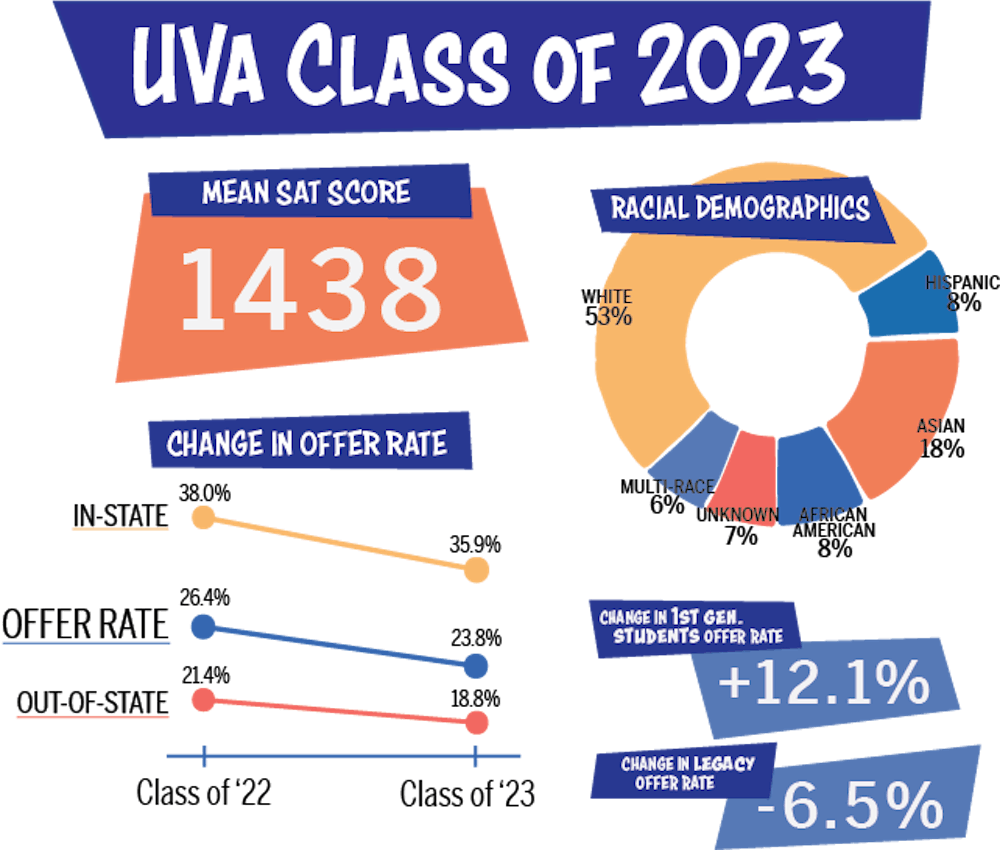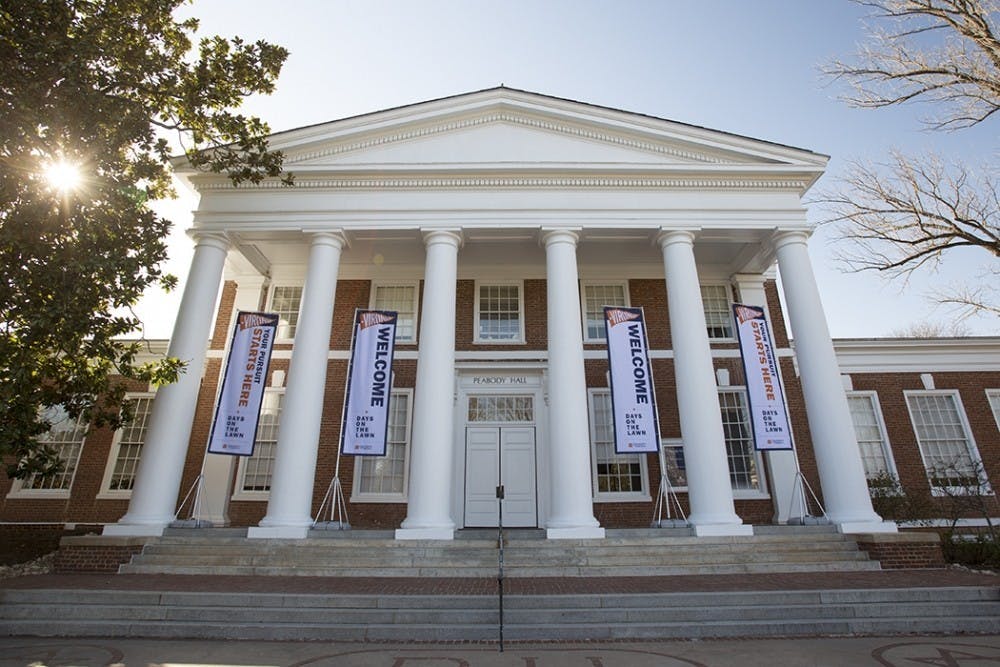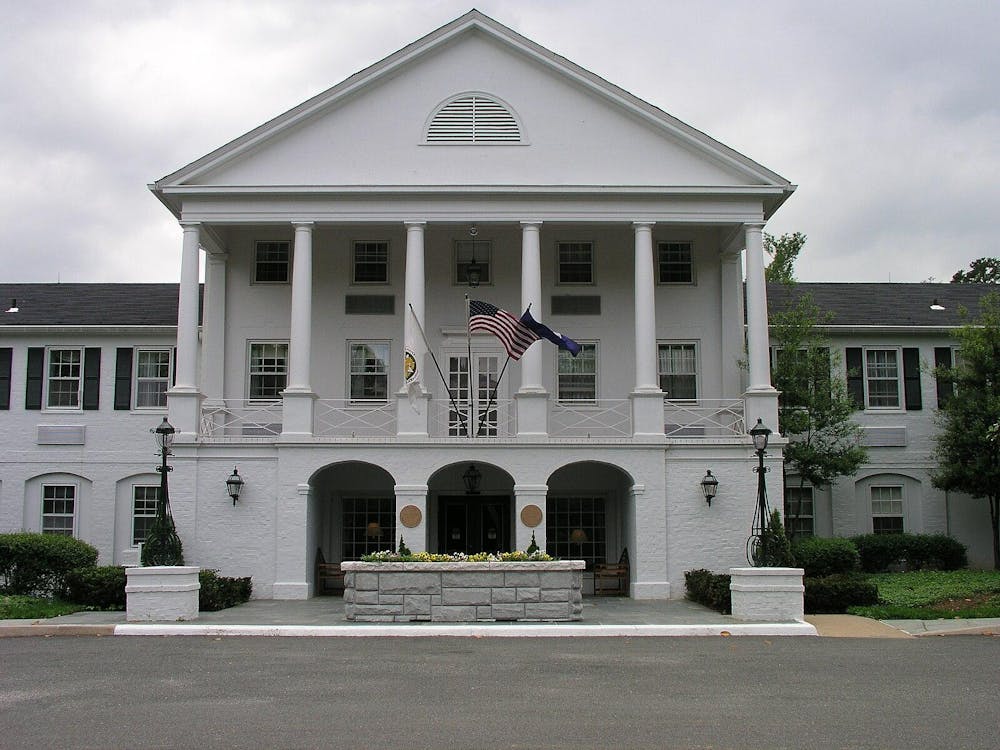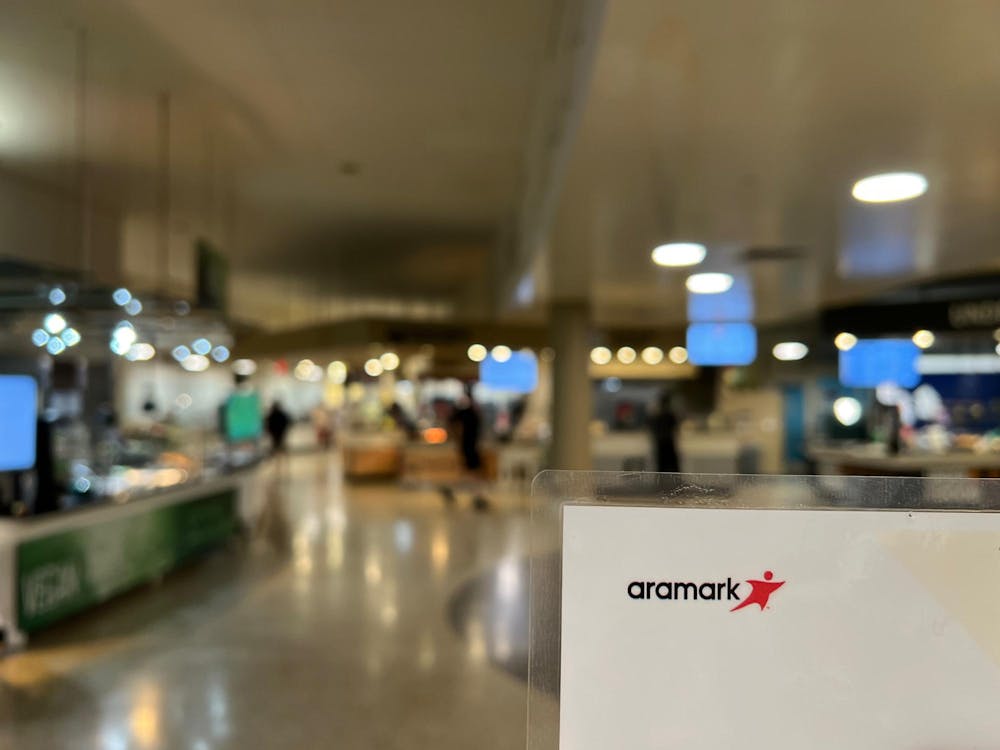The University Office of Undergraduate Admission released its regular admissions decision offers for the Class of 2023 last Friday. The University’s acceptance rate was 23.8 percent, with 9,726 offers of admission from a record-breaking pool of 40,869 applicants. Last year, the University had an offer rate of 26.5 percent.
In an interview with The Cavalier Daily, Dean of Admission Gregory Roberts said this year’s admitted class is the strongest academically and most diverse in the University’s history. Of those accepted, a record 37 percent are minorities — a 3.7 percent increase from last year. The admitted class is 48.35 percent white, 15.96 percent Asian, 7.57 percent Hispanic, 7.53 percent African American, 5.93 percent unknown, 5.72 percent multi-race, 0.03 percent Pacific Islander and 0.02 percent American Indian.
The University also extended 1,113 offers, or 11.44 percent of total offers, to students who would be the first in their families to attend college — an increase of 12.1 percent from last year’s first-generation applicants. The Office of Admission has not yet compiled data on economic diversity, but Roberts is “hopeful that this will be a class that will include more Pell-eligible students and students with financial need.”

Graphic by Maddy Sita
In addition, more than half of the admitted Class of 2023 is from out of state, and 8.9 percent are international students representing a variety of countries — an increase of 10.5 percent from last year’s class. Roberts said he hopes the University will be able to enroll five percent of the class as foreign nationals.
The University’s offer rate for out-of-state students dropped from 21.4 percent last year to 18.8 percent, while the offer rate for in-state students dropped from 38 percent to 35.9 percent. Additionally, 31.3 percent of applicants were extended offers to the Architecture school, 27.4 percent of applicants to the Engineering school, 23.6 percent to the College, 15.5 percent to Curry and 10.6 percent to the Nursing school.
The mean SAT scores of accepted students also rose to 1438, an increase from 1430 last year. Students accepted to the Engineering School had the highest mean SAT score — 1471 — of any first-year school at the University. The mean SAT score for the College was 1433, 1402 for the Architecture School, 1370 for Curry and 1350 for the Nursing School. The middle-50-percent range of ACT scores was 32-34 for in-state applicants and 33-35 for out-of-state applicants.
“We're looking for students who love to learn, who are self starters, who are willing to take some academic risk in college, students who are well prepared academically, students who want to be part of the broader University community and even Charlottesville, students who we think will make a difference on and off Grounds and in turn, students who will benefit from the opportunities that are provided here at U.Va.,” Roberts said.
In addition, the University extended 1,002 offers, or 10.3 percent of total offers, to legacy applicants whose parents attended the University — a decrease of 6.5 percent from last year.
“Last year was just an…unusually strong legacy class, but [this year] it wasn't a specific effort to decrease legacy as much as it was a specific effort to increase the number of offers to first-generation students,” Roberts said.
According to admissions data obtained by The Cavalier Daily, 42 percent of legacy applicants for the Class of 2023 received an offer of admission — nearly twice the rate of non-legacies. The mean SAT score of admitted legacy applicants was 1448 — 11 points higher than non-legacy applicants — and 94 percent were in the top 10 percent of their high school class.
“At U.Va. legacy is one of many factors — has been such as long as I’ve been here, and I have not been involved in conversations to reexamine legacy, but we do meet with the University administration every year to talk about policies and strategies,” Roberts said. “The fact of the matter is legacy is like first-generation, like race or geographic diversity or income diversity — it’s a part of the conversation when we’re trying to build this class.”
Last year, The Cavalier Daily reported that nearly 47 percent of legacy applicants received an offer of admission for the Class of 2022, while only a little over 25 percent of non-legacy applicants were offered admission.
In light of recent college admissions bribery scandals at nearly a dozen universities throughout the country — in which a number of wealthy parents are accused of paying millions to bribe college officials — the University’s Office of Admission says it does not have any connection with the Office of Advancement and is unaware as to whether a student’s family is a donor when reviewing applications.
However, Roberts added that at some point during the evaluation process, some students will get an extra look based on “institutional interest,” which includes children of donors, legacy applicants, first-generation applicants, committed athletes and children of faculty and staff.
“We consider a small number of cases every year that come to our attention that are of institutional interest, if you will,” Roberts said. “Those could include anything from children of faculty and staff, development cases, legacy cases where a family has been highly engaged with the University since graduating, and likewise it could include local students, and so there are many different types of institutional interests and priorities.”
“You're talking probably between out of 9800 offers — probably 50 to 75 get a second look,” Roberts added. “The cases that get reviewed a second time doesn't mean they're going to be admitted, and sometimes they were already admitted without that consideration.”
University spokesperson Anthony de Bruyn wrote in an email statement to The Cavalier Daily that the Office of Admission tracks up to 100 applicants each year using a “watch list,” which typically includes children or relatives of faculty or staff members, as well as applicants recommended by elected officials, Board of Visitors members and donors.
The University receives hundreds of unsolicited recommendations each year, which are one factor used to decide whether a student should be admitted — along with academic performance, test scores, extracurricular activities and community service involvement.
“Being on a watch list does not guarantee that an applicant will get in, as every student offered admission to UVA must be academically qualified to be here,” de Bruyn said. “All applicants go through the same admissions process, and all decisions are made solely by the staff of the Office of Admission. In some cases, we give personal notice of admissions decisions to those with strong affinity for the University, particularly in cases where applications are being denied.”
In April 2017, The Cavalier Daily reported that applicants whose families are notable donors to the University were flagged for special consideration during the admissions process.
“Our goal is to recruit an exceptionally talented, diverse, resilient, and service-oriented group of students, regardless of their economic circumstances,” de Bruyn said.
According to Assoc. Dean Jeannine Lalonde’s “Notes from Peabody” admissions blog, admitted applicants will learn if they were also accepted into the Echols, Rodman and College Science Scholars programs on the online admissions portal. They will also receive a letter in the mail soon. Students not chosen for Echols, which is the College honors program, or Rodman, which is the Engineering honors program, may apply for admission during their first-year at the University.
An additional 5,489 applicants were offered a spot on the waiting list, and those who accept their spot will be notified after May 1. Last year, only 13 students were admitted off the waiting list while 117 were admitted in 2017, 360 in 2016 and 402 in 2015.
The University’s enrolling class is targeted to be about 3,740 students. Students have until May 1 to accept their offers.







